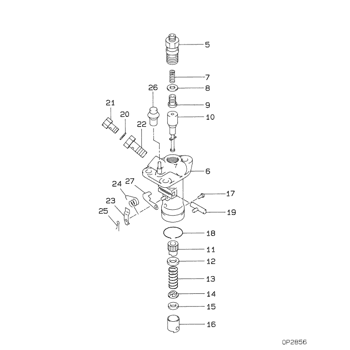Rating:
Information plate, tappet adju Denso
Include in ##:
09000-01370
as PLATE, TAPPET ADJU
Cross reference number
Part num
Firm num
Firm
Name
09031-10080
PLATE, TAPPET ADJU
0903110080
09031-10080
MITSUBISHI
PLATE, TAPPET ADJU
0903110080
22189-48035
TOYOTA
PLATE, TAPPET ADJU
0903110080
22189-48035
TOYOTA
PLATE, TAPPET ADJU
0903110080
22885-1330A
HINO
PLATE, TAPPET ADJU
0903110080
S2288-51330-A
HINO
PLATE, TAPPET ADJU
0903110080
MM500306
MITSUBISHI
PLATE, TAPPET ADJU
Information:
Fig. 1-Cylinder Head to Valve Head DistanceCylinder head to intake valve head distance (new) (1, Fig. 1) ... 0.037 0.007 inch(0.94 0.18 mm)Cylinder head to exhaust valve head distance (new) (2) ... 0.057 0.007 inch(1.45 0.18 mm)Disassembly
Fig. 2-Valve RemovalUsing a valve spring compressor, compress valve springs far enough to remove retainer locks.Release spring tension and remove valve spring cap (or rotator, if so equipped) and valve spring. Mark each part so that it can be reassembled in the same position it was removed from.Remove valves, marking them for reassembly.Repair
Fig. 3-Cylinder Head FlatnessMeasure cylinder head flatness (Fig. 3).Cylinder head flatness (maximum warp) ... 0.002 inch(0.05 mm)
Fig. 4-Cylinder Head ThicknessMeasure cylinder head thickness (Fig. 4), to see if cylinder head can be resurfaced.New cylinder head thickness ... 4.134 0.005 inch(105.00 0.13 mm)Minimum cylinder head thickness ... 4.104 inch(104.24)If cylinder head thickness is less than the minimum allowable thickness, do not resurface it. Install a new cylinder head.If cylinder head is thick enough to be resurfaced, remove only enough material to remove damage. Do not resurface cylinder head if its thickness will be less than the minimum allowable after resurfacing.
Fig. 5-Valve Face AngleIf necessary to resurface valve face, grind valve face at following angle (Fig. 5):
Fig. 6-Valve Seat AngleIf necessary to resurface valve seat, grind valve seat at following angle (Fig. 6):
Fig. 7-Valve Seat WidthWhen resurfacing valve seats, the valve seat width must be maintained (Fig. 7).
Fig. 8-Valve Seat Run-OutWhen resurfacing valve seats, the valve seat run-out must be maintained (Fig. 8).Valve seat run-out (maximum) ... 0.002 inch(0.05 mm)
Fig. 9-JDE-77 or JDE-87 Valve Seat PullerUse JDE-77A Valve Seat Puller to remove intake valve seat inserts or JDE-87 Valve Seat Puller to remove exhaust valve seat inserts if they must be replaced on 4276D, 6414D, or 6414T engine.Use JDE41296 Valve Seat Puller to remove valve seat inserts if they must be replaced on 4239D, 4239T, 6359D, or 6359T engine.
Fig. 10-JDE-7 Driver and JDE-86 or JD-287 Valve Seat InstallerUse JDE-7 Driver (1, Fig. 10) with JDE-86 valve seat installer (2) (for exhaust) and JD-287 valve seat installer (2) (for intake) to install valve seat inserts. Chill the valve seat installer and valve seat insert to -20°F (-29°C) before driving into cylinder head.Grind valve seats to obtain correct cylinder head deck to valve head distance.
Fig. 11-Valve Stem Oil ClearanceMeasure valve stem oil clearance (Fig. 11).Valve stem O.D. (new) (1) ... 0.372 to 0.373 inch(9.45 to 9.47 mm)Valve guide I.D. (new) (2) ... 0.375 to 0.376 inch(9.53 to 9.55 mm)Valve stem oil clearance (new) ... 0.002 to 0.004 inch(0.05 to 0.10 mm)Valve stem oil clearance (maximum) ... 0.006 inch(0.15 mm)If valve guide oil clearance is more than maximum allowable, but not more than 0.008 inch (0.20 mm), valve guides can be knurled.
Fig. 12-D20002WI Valve Guide KnurlerUse D20002WI Valve Guide Knurler (Fig. 12) as directed by manufacturer to knurl valve guides.If valve guide oil clearance is over 0.008 inch (0.20
